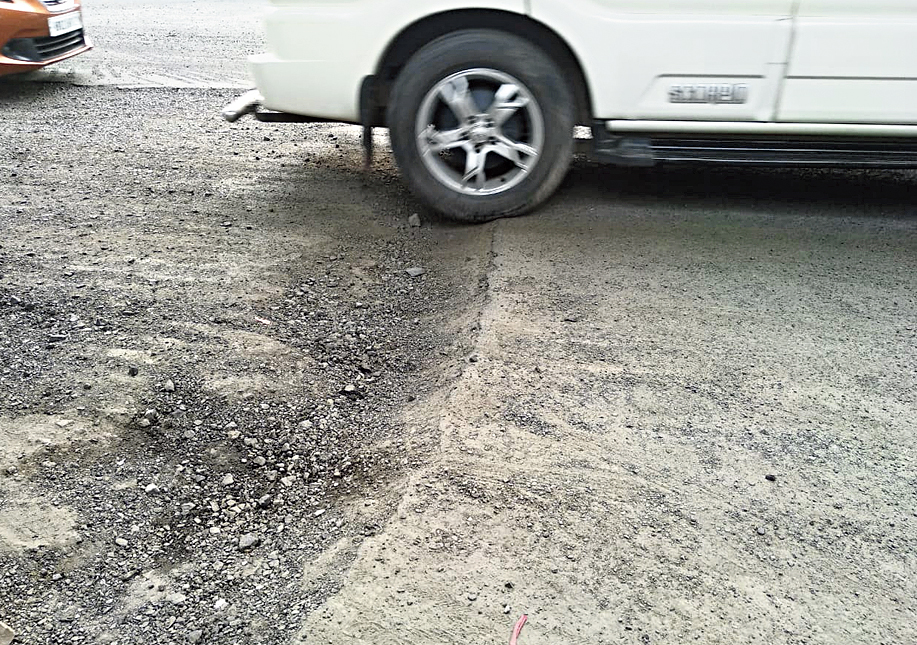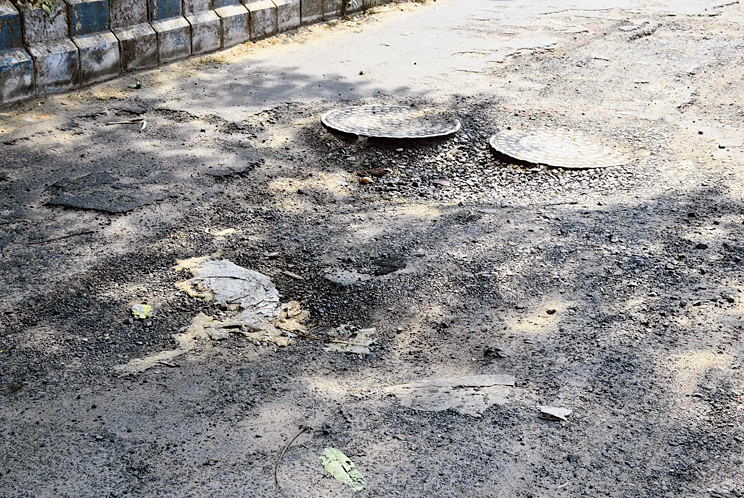The Bidhannagar Municipal Corporation (BMC) has finally started road repairs but their archaic road laying methods have got both residents and engineers of other government agencies worried about their quality and longevity.
Potholes dot all major roads of the township. Some are in worse state than others. The civic body is relying on patchwork — a layer of bitumen that is laid over craters — as a quick-fix solution.
Tapas Chatterjee, the mayoral council member in charge of roads, said Rs 75 crore had been sanctioned by the government for carrying out road repairs in the township. An initial tranche of close to Rs 10 crore had been released by the urban development department. “We will do the work in phases,” Chatterjee said.

An excavated section of Third Avenue where the asphalt has been completely scooped out by an earthmover a fortnight ago. Pictures by Snehal Sengupta and Brinda Sarkar

A worker pours molten bitumen on the road to do patchwork repairs in FE Block. (Saradindu Chaudhury)
Fingers pointed
Thousands of office-goers, students and others headed to Sector V have had to endure a bone-rattling ride every day for over four months because of the craters on a 1.5km stretch of Third Avenue from Karunamoyee to Wipro bus stop. A cloud of dust would envelop the area every time the wheels of passing vehicles kicked up the dust.
Two weeks ago, an earthmover scooped out the asphalt here, laying bare the brickwork that is the bed of the road. The chunks of asphalt were left in a heap on the roadside.
A Calcutta Metropolitan Development Authority engineer questioned the need for such deep excavation for carrying out patchwork. “They will now have to put sand and construction rubble to level it out. Once the asphalt is poured the area where the patchwork has been done will be at least six to eight inches higher than the rest of the existing road surface,” the engineer said.
He added that this level of unevenness on a road can lead to accidents. “There will be a sudden jerk when the wheels strike the patchwork that will be jutting out. It will be difficult for the drivers to control the vehicle,” said the engineer.
According to him, a road surface laid by mastic asphalt or concrete easily outlasts a surface redone with bitumen, which wears out faster. The economics of building roads also makes mastic asphalt a better choice in the long run, an engineer of the BMC road repairs department confessed.
Several engineers of the Calcutta Municipal Corporation, the Salt Lake civic body and Nabadiganta Industrial Township Authority, the civic agency of Sector V, said even mastic asphalt could be laid in a short span of time.

A heavily cratered section of the road between Tank 13 and Anindita More. The stretch is unlikely to be repaired in this phase. (Saradindu Chaudhury)
An engineer pointed out that the 2.5km long Broadway, which connects Salt Lake with the Bypass, was laid with mastic asphalt within a week, ahead of the Fifa Under 17 World Cup in September 2017, which was held at the Salt Lake stadium. The six-lane road is still smooth and has no craters.
Around Rs 3.8 crore is required to create a kilometre of mastic asphalt road. Though the cost is many times higher than patchwork repairs, it evens out in the long run because mastic asphalt doesn’t require frequent repairs.
“A concrete road is three times costlier to build compared to a bitumen stretch of the same length but lasts two decades. The longevity of a bitumen stretch, on the other hand, is a few months. A mastic asphalt road costs double and lasts around five years,” the engineer said.
Chatterjee had the same answer to both questions — why no mastic asphalt was being laid as well as why the civic body was focusing on patchwork and not relaying the roads completely — that there were budget constraints.
“Salt Lake still fares better. The roads in Rajarhat, Baguiati and Kestopur are also crying for repairs. We have to repair all of them,” said Chatterjee.
Residents on the stretches being repaired — however inadequately —can still consider themselves lucky.
Several other stretches in Salt Lake, including the canal bank road behind Baiskahi, AH Block and one near Tank 13, have had their brickwork exposed for the last couple of years. No repairs have been carried out after they were dug up to lay water pipelines that will flow in the water supplied from the New Town water treatment plant. Residents of these blocks said that let alone driving even walking was difficult along these stretches that resemble dirt tracks now.
Chatterjee said these stretches had not been relaid as they wanted to check if the water pipes would spring a leak. “Trials are being conducted. If we relay these stretches now then they will again have be repaved if the pipes leak and need maintenance,” said Chatterjee.










